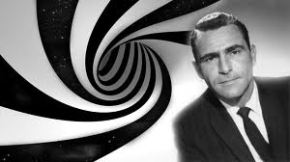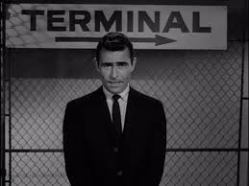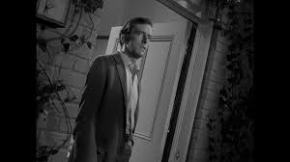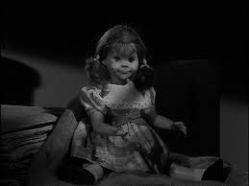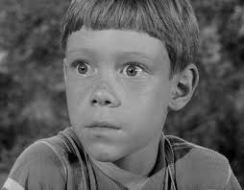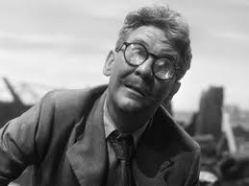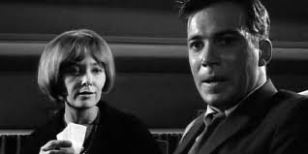“You unlock this door with the key of imagination. Beyond it is another dimension – a dimension of sound, a dimension of sight, a dimension of mind. You’re moving into a land of both shadow and substance, of things and ideas. You’ve just crossed over into …
THE TWILIGHT ZONE.”
Like a lot of Gen X types I first came across the Twilight Zone in late night syndication. For me I was lucky enough to experience the Zone during the summers of the early 1980’s via CKVR, an independent broadcaster north or Toronto that would fill their overnight schedule with affordable golden oldies programming. I was immediately hooked by the variety of story lines, the quality of acting and the breadth of imagination involved in the episodes. Aside from the likely, O. Henry-esque surprise endings and the the suave introductions by Rod Serling, you really never knew what you were going to get story-wise: out-and-out sci-fi, psychological thriller, morality play, comedy, horror, it was anyone’s guess. As Stephen King writes in Danse Macabre, “of all the dramatic programs which have ever run on American TV, it is the one which comes closest to defying any overall analysis.”
The Twilight Zone’s original broadcast run aired on CBS between October 2nd 1959 and May 22nd 1964. The five seasons consisted of 156 remarkable episodes written primarily by either Serling (92 TZ scripts!), Richard Matheson, or Charles Beaumont. As well as original teleplays by these three writers, short stories by the likes of Ray Bradbury, Jerome Bixby and Ambrose Bierce were also adapted into Twilight Zone episodes. Serling won Emmy Awards for Outstanding Writing Acheivement in Drama in the years 1960 and 1961 for the show. In 1963 ABC began airing its own sci-fi anthology show, The Outer Limits. Yet despite critical success Twilight Zone was canceled in 1964.
Serling was lured back to television to host and write 34 episodes of NBC’s Night Gallery from 1969 to 1973. He passed away in 1975.
It can be argued that Serling and the Twilight Zone paved the way for freaking out my entire generation. Not only was he penning TV space dramas before Gene Roddenberry was daring to go where his Star Trek federation would boldly go a few years later but he also was a step ahead of the whole occult movement in film (Rosemary’s Baby/ The Omen / The Exorcist) of the 1970’s. The Zone had freaky mannequins before Anthony Hopkins and Magic and before Spielberg’s Poltergeist was sucking little girls into television sets, Richard Matheson’s TZ episode gave us a ‘Little Girl Lost’. Serling co-wrote Planet of the Apes, and if you look on the internet you can find a 22-minute cut of the film that reduces it to a perfect Twilight Zone Episode.
So for me those second-hand episodes came at a perfect time. I was just getting in to the short fiction of Harlan Ellison and Stephen King and The Twiight Zone seemed to complement it perfectly. Stories, ideas, and imagination unleashed! Clearly, me and my sexually inactive friends were not the only ones spending our summer nights alone watching re-runs of the Twilight Zone. All of a sudden horror anthology was coming at us from everywhere. In 1982 Stephen King and George Romero gave us the EC Comics inspired Creepshow film, which spun off into the late night low-budget horror anthology show Tales from the Dark Side a year later.
Also in 1983 the Twilight Zone hit the big screen after years of renewed interest through television syndication. Directors John Landis, Stephen Spielberg, Joe Dante and George Miller were enlisted to bring the TZ Movie to life. And following the success of the film, CBS brought the Twilight Zone back to television for a new generation on Friday September 27th, 1985. Hugo-Award winning writer Harlan Ellison was hired as the show’s script supervisor. Spielberg even began his own anthology series, Amazing Stories, on NBC in 1985. Anthology horror/sci-fi was riding a renewed wave of popularity.
For a few years now the entire original Twilight Zone series has been available through Image Entertainment on DVD and Blu-ray, which includes all original episodes, as well as the five episodes that were missing from syndication. The package also includes exceptional bonus features: commentaries with actors and directors and a Rod Serling documentary.
So, consider if you will, a list compiled for your perusal, intended not as an exhaustive Best Of, but rather a subjective sampling of some of this blogger’s favourite episodes:
25 Timeless Classics From
The Twilight Zone
#25 – The Bard (Season 4) Written by Rod Serling. A hack TV writer enlists William Shakespeare as a ghost writer and becomes an overnight sensation. Burt Reynolds has a bit role parodying Marlon Brando as Rocky Rhodes.
#24 – What’s in the Box (Season 5) Written by Martin M Goldsmith. A particularly violent domestic yarn about a TV that broadcasts the future starring William Demarest, Joan Blondell and the voice of Winnie the Pooh, Sterling Holloway.
#23 – Five Characters in Search of an Exit (Season 3) Written by Serling. Toy Story meets Pirandello. ‘nuff said.
#22 – Back There (Season 2) Written by Serling. A time travel story where Russell Johnson plays a man trying to convince people that President Lincoln will be shot if they don’t act.
#21 – Once Upon A Time ( Season 3) Written by Matheson. Buster Keaton’s performance alone in this partially silent episode makes this odd slapstick piece worthwhile. The story: A janitor from 1890 hijacks a time travel hemet that brings him to 1962. Kind of a sci-fi Sorcerer’s Apprentice.
#20 – The Shelter (Season 3) Written by Serling. The missiles are in the air and neighbours are at each others throats to get inside one family’s fallout shelter.
#19 – Third From The Sun (Season 1) Written by Serling. Based on Richard Matheson’s short story about a family trying to escape annihilation on the eve of nuclear catastrophe. An absolute classic, wonderfully shot by DOP Harry Wild and directed by Richard L Bare. Fritz Weaver stars.
#18 – Where Is Everybody? ( Pilot) Written by Serling. Earl Holliman plays an amnesiac in a town absolutely devoid of people or clues to where everybody went. The pilot sets the template perfectly. There’s a sign post up ahead. You have definitely entered the Twilight Zone.
#17 – Kick The Can (Season 3) Written by George Clayton Johnson. The series often dealt with the desire of returning to simpler times but this episode handled it in a magical way that was beyond pure escapism or madness. It was also one of the stories later adapted for the 1983 feature film.
#16 – Mr Dingle The Strong (Season 2) Written by Serling. This one epitomizes the goofy story lines. Basically it’s the “Bullied weakling becomes Superman and bests his Bully” tale BUT not only does it have two wacky Martians, two zany Venusians, the always brilliant Burgess Meredith as Dingle but, wait for it, DON RICKLES AS A BAD GUY!
#15 – Living Doll (Season 5) Written by Beaumont. Another out and out classic and this one is the stuff of pure nightmares. The doll Talky Tina says things like, “you’d better be good to me!” and “I’m going to kill you!” and has been spoofed (Krusty) and ripped-off (Chucky) repeatedly over the years. The original is still a chilling view.
#14 – A Stop At Willoughby (Season 1) Written by Serling. The overworked automaton was another recurring motif on the show. In this season one classic a hen-pecked, stressed out ad man is drawn to the bucolic yet apparently non-existent town of Willoughby.
#13 – The Hitch-Hiker (Season 1) Written by Serling/ adapting a radio play by Lucile Fletcher. After experiencing a tire blow out, Nan Adams sees the same hitch-hiker again and again on her cross-country drive. One of the creepiest film or television productions ever.
#12 – It’s A Good Life (Season 3) Written by Serling/ based on a short story by Jerome Bixby. Six year old Anthony is the monster that controls everything and everyone in Peaksville, Ohio.You don’t want to get on his bad side or he’ll wish you away, into the cornfield with the others.
#11 – The Obsolete Man (Season 2) Written by Serling. The episode tells the story of a persecuted librarian living in a repressive Super-state. Starring TZ All-Stars Burgess Meredith and Fritz Weaver the tale is part 1984, part Fahrenheit 451 and just as relevant in the Patriot Act era as it was during the Cold War, if not more so.
#10 – Miniature (Season 4) Written by Beaumont. Robert Duvall gives a creepy, psycho performance that is right up there with Anthony Perkins’ Norman Bates and DeNiro’s Travis Bickle in this episode about a man who falls in love with a wooden doll in a museum. Season four consisted of hour-long episodes which allowed Duvall room to really breathe life into this deluded maniac.
#9 – An Occurrence at Owl Creek Bridge (Season 5) Written by Robert Enrico. Based on the story by Ambrose Bierce. This remarkable french short film about an American Civil War execution was purchased and aired as an episode of the Twilight Zone, with Serling’s opening and closing narration added on. It also won an Oscar.
#8 – Time Enough At Last (Season 1) Written by Serling. Yet another Burgess Meredith episode and perhaps the one everyone thinks of when recalling a Twilight Zone twist ending. No spoilers here though! Let us say this – meek bank clerk Henry Bemis finds time enough at last to read once the rest of the world is destroyed in an atomic blast …
#7 – He’s Alive (Season 4) Written by Serling. Dennis Hopper gives a chilling performance as an American neo-Nazi who is given tutelage by the ghost of Adolph Hitler.
#6 – Little Girl Lost (Season 3) Written by Matheson. The terrifying and heartbreaking tale of a small girl who slips into another dimension. A brilliant script. You may know it through it’s Simpsons parody.
#5 – The Eye of the Beholder (Season 2) Written by Serling. A young woman undergoes last-chance plastic surgery to save her from living life as a freak – if it works. Everything about the episode is classic. The way it is shot; the make-up; its even tone; its political commentary; its shock ending. It’s ALL classic Twilight Zone.
#4 – To Serve Man (Season 3) Written by Serling. A seemingly benevolent group of aliens land on earth. Their only intention is “To Serve Man”. Again, you know you’ve made it if the Simpsons have immortalized an episode.
#3 – The Invaders (Season 2) Written by Matheson. In an all but wordless episode an old woman living alone in the country is terrorized by tiny space invaders who have come into her house. Agnes Moorhead gave a harrowing performance that will forever have me looking for little spacemen instead of mice when I hear scurrying about at night. Definitely one of the best of the best.
#2 – The Monsters Are Due On Maple Street (Season 1) Written by Serling. When the power goes out in a suburban neighbourhood mob mentality and paranoia quickly sets in. When the the show was relaunched and this episode was remade in the 2000‘s the subtext was tweaked slightly to reflect post-911 hysteria rather than Cold War paranoia.
#1 – Nightmare At 20,000 Feet (Season 5) Written by Matheson. In many ways by the time Season 5 rolled around CBS budget restrictions forced many of the Twilight Zone scripts to limit the amount of sets and set-ups on the show. This worked in its favour as Nightmare at 20,000 Feet only needed one set – the airline on which William Shatner’s character, Robert Wilson has his mental breakdown. The single set, and tight quarters adds to the mania and claustrophobia of this brilliant episode. Pre-Kirk Shatner is fantastic as he watches the Gremlin destroy the wing of the airliner. Director Richard Donner (Superman, The Omen) created one of the most memorably terrifying moments in television history.
The enduring legacy of the original Twilight Zone series continues on nearly a half a century after its cancelation by CBS. In 2013 the members of the Writer’s Guild of America were polled, asked for the best written television shows of all-time. Serling’s Twilight Zone ranked #3 over all in the the list of the Top 101. The compilers of the list noted, “No show in the history of television has lingered in the imagination quite like Rod Serling’s anthology series. The actors were less the stars of the Twilight Zone than the stories themselves.”

